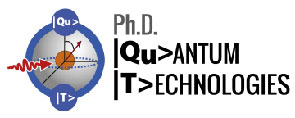Speaker
Description
A Josephson Travelling Wave Parametric Amplifier (TWPA) is a non-linear device which consists of a long array of repeating unit cells containing Josephson junctions. In our case the unit cell consists of a superconducting loop with three large (high critical current) and one small (low critical current) Josephson junctions (so-called SNAIL-cell - superconducting nonlinear asymmetric inductive element [1]). The nonlinearity of this device gives rise to parametric amplification: namely in presence of an intense input pump at frequency ωp and a weak input signal at frequency ωs, the output signal will be amplified and the idler tone at frequency ωi = ωp – ωs will be generated. In addition, due to the nonlinearity harmonic generation takes place, affecting amplification performance of TWPAs. In this work, the appearance of harmonics in such device is studied in detail.
Our experiment was carried out in the laboratory of Quantum Technologies of Naples University Federico II. The TWPA was placed in a Triton cryostat of Oxford Instruments which was cooled down to 7 mK in order to achieve the necessary amplification. We used SNAIL TWPA consists of 700 unit cells [2]. The device was fabricated at Neel Institute, CNRS in Grenoble. For this device we experimentally observe the appearance of second and third order harmonics in presence of pump and signal for different values of the external magnetic flux threading the SNAILs. We study harmonic generation at both zero and half magnetic flux quantum. The results of experiment are in agreement with the theory according to which the presence of second harmonic depends on nonlinearity β (three-wave mixing coefficient) and third harmonic generation depends on γ (four-wave mixing coefficient) [3]. Both β and γ depend on applied magnetic flux.
Simulation of SNAIL TWPAs with PSCAN2 software package (a circuit analyzer that supports Josephson junctions) was also performed for comparison with experimental data and analytic predictions.
[1] N. E. Frattini, U. Vool, S. Shankar, A. Narla, K. M. Sliwa, and M. H. Devoret, “3-wave mixing Josephson dipole element,” Appl. Phys. Lett, vol. 110, no. 22, pp. 1– 5, 2017.
[2] Arpit Ranadive, Martina Esposito, Luca Planat , Edgar Bonet , Cécile Naud , Olivier Buisson, Wiebke Guichard1 & Nicolas Roch, “Kerr reversal in Josephson meta-material and traveling wave parametric amplification” Nature Communications, volume 13, article number: 1737 (2022)
[3] A. B. Zorin, “Josephson Traveling-Wave Parametric Amplifier with Three-Wave Mixing,” Physical Review Applied, vol. 6, no. 3, pp. 1–8, 2016.

